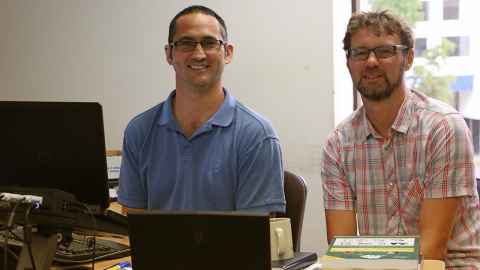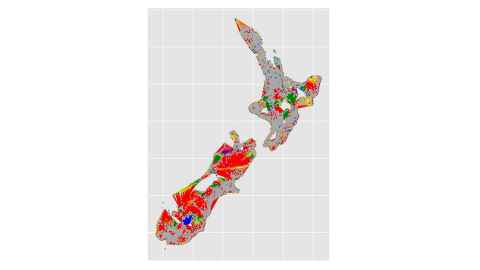Modelling the pandemic
24 April 2020
For the past few weeks, COVID-19 modelling has been the bulk of work for Dr Mike O’Sullivan Jr from the Department of Engineering Science.

Along with Associate Professor Cameron Walker from his department, he is collaborating with Associate Professor Ilze Ziedins from the Department of Statistics, and experts from Te Pūnaha Matatini, a nationwide research centre for complex systems and network science. Dr O’Sullivan tells us more about their involvement and how it is contributing to Aotearoa’s government policies and COVID-19 response.
Working with urgency
“One of our main projects started when a group at Te Pūnaha Matatini worked on the initial differential equation model of how bad this can get for New Zealand using some numbers from outbreaks overseas. These involve infection rates and recovery time, so the magical number R0 is basically the number of people you’ll infect during your infectious period. For COVID-19, evidence suggests it’s somewhere between two and three in the absence of control measures.
“You can quickly see how this can get out of control. If you get infected by someone, then go on to infect two and a half people, and that continues on and on, the potential number of people who might die in New Zealand could be as high as 80,000, so our government agencies had to act fast. Some decisions were to be made by the Ministry of Health before the (Level 4) lockdown on whether they needed to place mobile clinics in areas around the country. This didn’t happen, but it’s also crucial to understand why: although the initiative aims to prevent disease spread, GPs may also lose patients and thus struggle financially to stay open. There are reports out of America of primary care practices that are struggling to keep operating due to a reduction in income.
“This is how Associate Professors Ilze Ziedins and Cameron Walker and I got involved. There were some gaps in the original epidemic models – they were fundamental to the information New Zealand needed at the time, but we still don’t know what happens when people end up in hospital, for example. Our focus turned to how ICUs and hospitals will cope if the infection numbers get really bad. We looked at population models, then created stochastic models that allow more flexibility in modelling, which is particularly important so we can see the effects of people ‘immigrating’ back into New Zealand with COVID-19.
“We can’t overestimate our healthcare system. One of the clinicians we’ve spoken to is particularly worried about their capacity if a lot of people do get sick. New Zealand has a grand total of 500 ICU beds at a stretch, but realistically, it’s closer to 250-300. In normal practice, one nurse is allocated per bed, but we’ve seen numbers closer to 1:6 overseas – your fatality rate rises when you’re not monitored as closely.”
“We’re also looking at the effects on medical staff – not just how many nurses and doctors become exposed to the illness, but what happens when our ICU capacity drops. The bottom line is, when ICUs are over capacity – as has happened in countries like Italy – more people will start dying. If this happens, then clinicians will face tough decisions about whether ICU beds should be given to the sickest people or the ones most likely to survive. No one wants to make these decisions.”
“The obvious challenge here involves numbers we still don’t know. We’ve customised our transmission rates to what we’re seeing in New Zealand, but can’t always be sure about recovery times for various stages of the disease, where people are staying as they are infected, or if people who are infectious without being symptomatic are coming into contact with others. Having enough confidence in our models to inform policy can be pretty scary, but we’re updating our models with new data daily – they’re built using pipelines of data so we can see if the models and real-world data are matching up well.
“The work goes beyond the percentage of infected people who will show up to hospitals – we’re modelling patients being admitted into wards and escalations into ICU, given the various control scenarios provided by the government’s alert level system. There’s some urgency here, and big questions such as: can we contain the infection by closing borders, or if we’re capable of delaying it in hopes of a vaccine. I don’t know the answers, but modelling can provide possibilities under different scenarios.”
Preparing for the future
“We’ve also been working on simulating the effects of geography on the transmission of COVID-19 in New Zealand. This started with getting some data from the last Census – I’ve been looking at meshblocks, small chunks of New Zealand that have about the same population. They’re usually smaller than suburbs and the length of a few streets, and the country is broken up into a lot of them. They’re bigger in rural areas where the populations are lower and smaller in cities.
“Combining meshblock data with information from maps allowed me to build transmission networks. It’s like saying ‘if these two meshblocks were neighbours, then people may move between them; they’re connected. If the closest supermarket to both meshblocks is the same, they’re connected. Similar connections exist if meshblocks share the same petrol station or primary care clinic, such as a GP.”

“We’ve mapped this for all meshblocks in the country, and will start integrating them with the stochastic model, so we can consider how, say, if I lived in Auckland, I can’t infect someone in Otago, but I can pass it on to someone in my meshblock or to someone from a nearby meshblock when I go to a supermarket without being aware of my infection. The infection spread is modelled using groups of nearby people – the ones on your street, or the next block over. It may help us evaluate how geography affects the spread and see how clusters can form.”
“This is valuable information because we’re somewhat limited by geography under a lockdown. These models are really about informing how something like COVID-19 spreads, so while this is less urgent for now, it helps us be more prepared for the future. Even if they aren’t used in this instance, we’ll be able to reuse a model like this for a different pandemic or even something seasonal like the flu, and hopefully get good information more quickly.”
Science for humanity
“Te Pūnaha Matatini has a couple of guiding principles, one of which is kindness. To me, this goes with helping others. We’re not just doing this because we love investigating complex systems, but because we want to do research that makes an impact, that helps people.”
“I’m also happy to see people appreciating how modelling can really inform decision-making. People all over the world are doing it, because it’s a way to answer big questions posed by governments. This is all new to us – you can’t really look at SARS or MERS because it never got to this scale, and you can’t look back to the 1918 influenza pandemic, because things are really different now.”
“I’ve been really impressed by how quickly teams have come together and model at speed. We’re seeing a lot of people are working on different pieces in parallel. Some of our work overlaps, but that’s okay because different approaches give us interesting solutions and we’re validating our models against each other’s results. It’s an amazing case study of what New Zealand research can offer stakeholders in a short span of time, and being able to get feedback to improve the research. The ability for the data to get to the right people has to do with our government’s openness to working with our experts – it’s a great example of government and science working together.
“I don’t want to speak for everyone, but I think a lot of New Zealanders are proud of how we’ve reacted as a country. I think the modelling has been a big part of – and is justifying – our government’s decisions and we’re developing faith in smart people doing good stuff with good data. I think a lot of it has to do with the science communicators we’ve had, such as Dr Siouxsie Wiles and Dr Shaun Hendy. It’s great that they’re able to successfully explain things and New Zealand has listened.
“I think leadership’s been really strong, but the public really did work together. The public response, and seeing our model’s results correlate with the current infections trending downwards gives us more confidence in our ability to understand what’s to come, to inform policy decisions and determine which resources are critical.”
Listen to Dr Mike O'Sullivan talk more about meshblocks, operations research, and modelling COVID-19 on Stanford Engineering's The Future of Everything podcast.